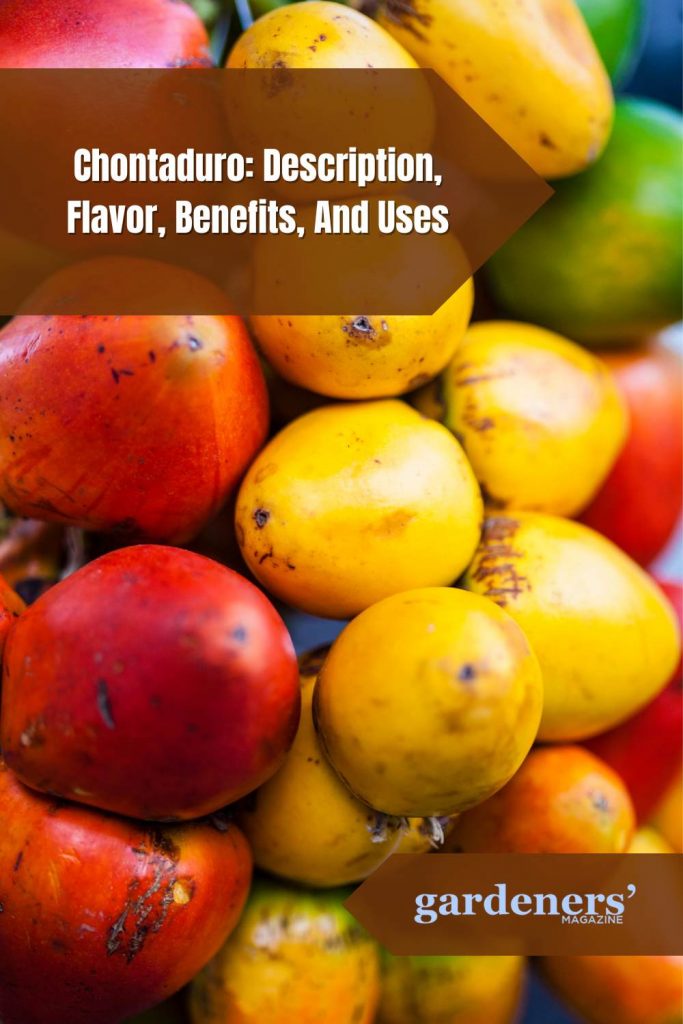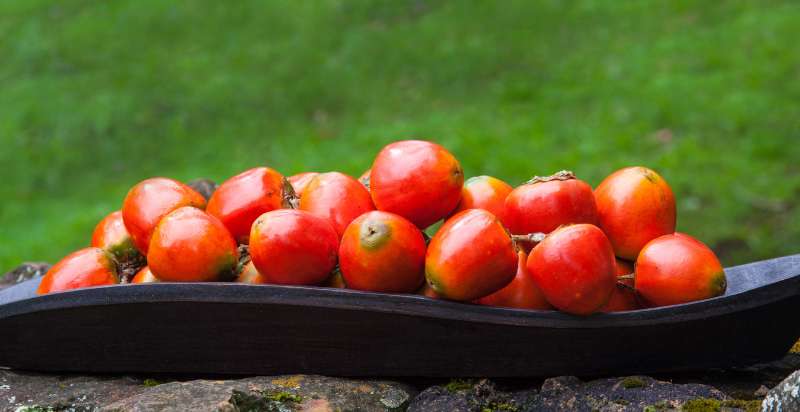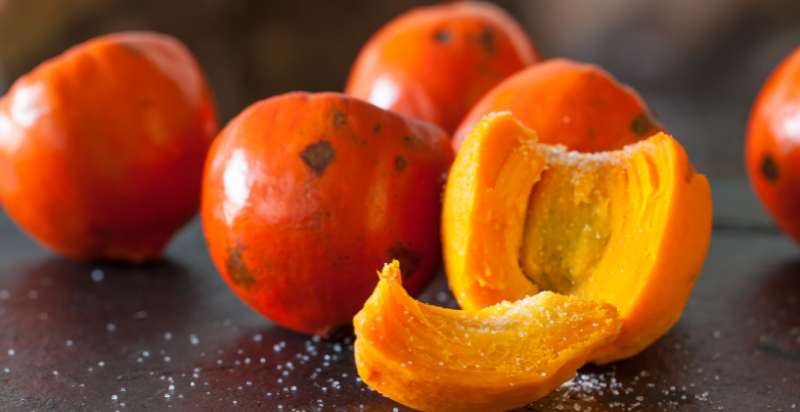Chontaduro is a tropical fruit native to the rainforest regions of South America. Locals have enjoyed it for centuries, and its popularity is growing worldwide. The fruit has a unique flavor and texture, making it stand out. In this article, we’ll discuss what makes Chontaduro so special, including its nutritional benefits, how to buy and prepare it, and even some recipes for it in various ways. We hope you’ll find all the information you need to enjoy this amazing fruit.
What is Chontaduro?
Chontaduro is a type of palm fruit native to South America and traditionally eaten in Colombia, Panama, and Ecuador. It has many names in different languages: Chonta or Palmito in Spanish, pupunha or pejibaye in Brazilian Portuguese, coquito chontaduro in Panama, and guama in Venezuela. The fruit has a hard, brown shell and soft yellow flesh. It tastes sweet and is often eaten raw or cooked in various dishes.
Chontaduro can also be used to make drinks, snacks, desserts, and more. Its nutritional value means it is considered a superfood with high protein levels, vitamins, and minerals. It has become popular as a healthy snack or meal addition and is even used in energy bars. It is also said to aid digestion and help fight diabetes.

History and Origin Chontaduro:
The Chontaduro is a fruit native to the tropical regions of South America. It is believed that the oldest known cultivation of the Chontaduro dates back to 500 BC in Ecuador, where it was considered a sacred food and used as currency. The fruit has been cultivated in Peru, Venezuela, Colombia, and Panama for centuries.
Chontaduro is an oval-shaped green fruit with tough, leathery skin. Inside, the soft flesh has a sweet and nutty flavor, often compared to a combination of dates and figs. The seeds are large and black and can be eaten when roasted. Chontaduro has been prized for centuries throughout South America due to its health benefits and delicious flavor. The fruit is still widely cultivated and eaten today, with its popularity increasing due to its nutritional value and versatility in the kitchen. It is quickly becoming a popular food item throughout Latin America and beyond.
Description of the Chontaduro:
Chontaduro is a type of edible fruit that grows in many countries in South America. It has a hard, brown outer shell and soft, yellowish-green flesh. The size of the Chontaduro can vary depending on the variety, but typically it measures between 5 and 10 cm (2-4 inches) in diameter. Its taste is sweet, and it has a slightly nutty flavor. The pulp of the Chontaduro is often eaten fresh or cooked into sauces, jams, and other dishes. It can also be dried and used as a topping on desserts or salads.
Flavor Profile of the Chontaduro:
The flavor profile of this rare fruit consists of notes of sweet, nutty, and caramelized flavors unique to the area. Its creamy texture is also a treat for those who enjoy sampling products in the region. Chontaduro can be used as a topping on ice cream and desserts and can even be eaten with pancakes or toast. It is an interesting addition to any dish and can be used in many ways. The unique taste of the Chontaduro is sure to make an impression on anyone who tries it.
Health Benefit of the Chontaduro:
Chontaduro is a fruit native to tropical regions of Central and South America. It has numerous health benefits, often called the “miracle fruit” due to its wide range of nutrition. It’s high in fiber, vitamins B1, B2, C, and E, minerals such as magnesium and zinc, and other vital nutrients.
Chontaduro also contains heart-healthy fats like omega-3 and omega-6 fatty acids, which help to reduce blood pressure and cholesterol levels. It’s a great energy source, providing complex carbohydrates that are slowly digested and absorbed into the body for sustained fuel.
Additionally, chontaduro is an excellent source of dietary fiber, which is beneficial for digestion, weight management, and overall health.Finally, chontaduro has anti-inflammatory properties that help support the immune system and protect against infection and disease. These benefits make it an ideal choice for maintaining a healthy diet.
Cultivation of the Chontaduro:
The Chontaduro palm is a low-maintenance crop that grows well in most soils and temperatures ranging from 50 to 95 degrees Fahrenheit. It prefers full sun, though it will tolerate some shade. It is drought tolerant and can be grown without irrigation, although it may produce better yields with regular watering. The trees grow slowly and need minimal pruning for fruit production.
When planting, the tree should be placed in a hole slightly larger than the root ball, with the top of the roots just above soil level. The trees should be spaced 20-30 feet (6-9 m) apart to allow future growth and light to penetrate the canopy. The soil should remain consistently moist but not soggy.
Fertilization should be applied twice yearly in the spring and fall seasons using a balanced fertilizer. Pruning should occur in the spring when new growth emerges, removing dead or damaged branches and competing shoots growing too close together. This will help ensure good air circulation necessary for healthy fruit production.
Harvesting of the Chontaduro:
To harvest the Chontaduro, the fruits should be at least 2.5 cm in length and 1.5 cm in width when ripe. The skin should also have changed from a light green color to a dark yellowish or orange hue before it is ready for harvesting. It is important to pick the fruit carefully as they are delicate and easily damaged. Once harvested, the fruits should be washed and dried before storage. The Chontaduro can be eaten raw or cooked, depending upon preference. It can also make jams, jellies, and other traditional desserts. Additionally, it is often used in soups, stews, and salads for added flavor.
The harvesting season of the Chontaduro usually runs from May to August but can vary depending on the location. Harvesting the fruit in the early morning when it is cooler and less likely to be damaged by heat or insects. Once harvested, the fruits should be handled with care as they are delicate and easily bruised.

Where Does Chontaduro Grow?
Chontaduro is mostly grown in northern Colombia and the eastern coast of Ecuador. In Colombia, it’s mainly found around the departments of Valle del Cauca, Antioquia, Santander, Bolívar, and Risaralda. The fruit has also been spotted growing as far south as Peru and Venezuela.
The Chontaduro palm is an incredibly hardy tree and can grow in difficult conditions. It has grown in areas up to 7,500ft above sea level and can survive drought-like conditions of up to six months without regular watering. The tree requires a hot tropical climate and plenty of direct sunlight to flourish. It typically develops best when the temperatures range between 24 °C to 30 °C with a mean annual rainfall of 800-1200mm. The tree also needs soil that is well-drained and rich in organic matter for best results.
Chontaduros are not typically grown in orchards but are scattered throughout wild forests or rural areas. Occasionally it can be found growing in small family gardens or near rivers. The tree is also commonly planted across many rural areas that lack water sources to help retain moisture in the soil and provide food for local inhabitants.
What do you Need to Keep in Mind when Buying Chontaduro?
When buying Chontaduro, it is important to consider a few factors:
- You should select a product that is fresh and of high quality. It should be free from mold or insect infestations, and the skin should be intact without blemishes.
- Carefully check the size of the Chontaduros-smaller sizes tend to be sweeter.
- If you purchase a large chontaduro, store it in a cool and dry place for maximum freshness.
- You should refrain from buying from unknown sources since the quality may not be guaranteed.
Following these tips can ensure that you buy the best-tasting Chontaduro possible!
What is the Best Way to Store Chontaduro?
Chontaduro should be stored in a cool, dark place to ensure optimal flavor and freshness. It is best to keep it in an airtight container or bag. Ensure the container is kept from direct sunlight, heat sources, and moisture.
If you are storing large quantities of Chontaduro for long periods, it is recommended that you keep it in the refrigerator or freezer. Chontaduro can also be stored in a dehydrator or vacuum sealed for long-term storage. The key is to keep the Chontaduro dry, cool, and away from direct sunlight or heat sources. Properly stored, Chontaduro should stay fresh and delicious for up to 6 months.
How to Use Chontaduro in Recipes with Others?
Chontaduro can be used in a variety of recipes, from sweet to savory. One way to enjoy this delicious fruit is by combining it with other fruits and vegetables. Here are some ideas for including chontaduro in your favorite dishes:
- Salads: Try adding diced chontaduro to salads for an extra crunch and sweetness. It pairs especially well with cucumber, mango, avocado, and other fruits and veggies.
- Salsas: Make a delicious chontaduro salsa by combining diced chontaduro with your favorite salsa ingredients. Add some heat to the mix by including jalapenos or habaneros.
- Jam: Make a sweet and tangy chontaduro jam by combining diced chontaduro, sugar, and lemon juice. Spread it on toast or add it to your favorite desserts.
- Pies: Add diced chontaduro to pies for a unique flavor twist. It pairs especially well with apples, strawberries, and other fruits.
- Beverages: Add diced chontaduro to your favorite beverages, such as lemonade or sangria, for a unique flavor.
- Desserts: Include diced chontaduro in your favorite desserts for a sweet and tangy twist. It goes especially well with cakes, pies, tarts, and other baked goods.
No matter how you choose to enjoy it, chontaduro provides an excellent way to incorporate some extra flavor and nutrition into your favorite recipes. Even better, it’s incredibly versatile and can be used in a variety of dishes. So why not give it a try? You may just find that you’ve discovered your new go-to ingredient!

Conclusion:
Chontaduros are delicious and nutritious fruit that can be used to add flavor and nutrition to many different dishes. Thanks to their high pectin content, chontaduros create a jelly-like consistency when cooked, so it is important to remember to add a bit of sugar or other sweeteners before combining them with other ingredients. Whether you use them in savory dishes or desserts, chontaduros will surely add an exciting new flavor that will have everyone asking for seconds! Enjoy experimenting with this tasty fruit in your favorite recipes!
- Everything You Wanted to Know About Red Tamarillos - June 2, 2025
- A Guide to Tulips: Everything You Need to Know & More… - June 2, 2025
- Guanabana: Description, Flavor, Benefits, And Uses - May 27, 2025

2 thoughts on “Chontaduro: Description, Flavor, Benefits, And Uses”
Comments are closed.